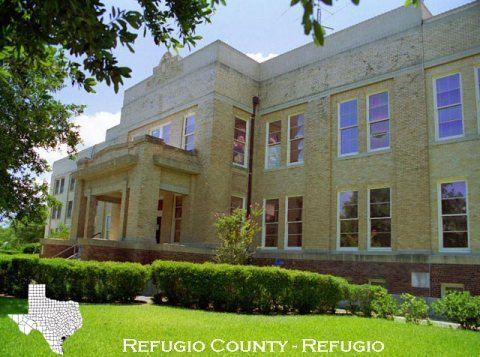Founded 1836 Population 7,305 (2013) | Website www.co.refugio.tx.us Area 2,119 km² County seat Refugio | |
 | ||
Rivers San Antonio River, Medio Creek, Copano Creek | ||
Refugio County (/rᵻˈfjʊəri.oʊ/ ri-FYOOR-ee-oh) is a county located in the U.S. state of Texas. As of the 2010 census, the population was 7,383. Its county seat is Refugio. The county was created as a municipality of Mexico in 1834 and organized as a county in 1837.
Contents
- Map of Refugio County TX USA
- Geography
- Major highways
- Adjacent counties
- National protected area
- Demographics
- Geology
- Healthcare
- Cities
- Towns
- Census designated place
- Ghost towns
- References
Map of Refugio County, TX, USA
Geography
According to the U.S. Census Bureau, the county has a total area of 818 square miles (2,120 km2), of which 770 square miles (2,000 km2) is land and 48 square miles (120 km2) (5.8%) is water.
Major highways
U.S. Highway 77 Alternate/U.S. Highway 183
Adjacent counties
National protected area
Demographics
As of the census of 2000, there were 7,828 people, 2,985 households, and 2,176 families residing in the county. The population density was 10 people per square mile (4/km²). There were 3,669 housing units at an average density of 5 per square mile (2/km²). The racial makeup of the county was 80.22% White, 6.77% Black or African American, 0.56% Native American, 0.29% Asian, 0.05% Pacific Islander, 10.42% from other races, and 1.67% from two or more races. 44.58% of the population were Hispanic or Latino of any race.
There were 2,985 households out of which 31.60% had children under the age of 18 living with them, 55.10% were married couples living together, 12.80% had a female householder with no husband present, and 27.10% were non-families. 24.60% of all households were made up of individuals and 11.50% had someone living alone who was 65 years of age or older. The average household size was 2.59 and the average family size was 3.07.
In the county, the population was spread out with 26.10% under the age of 18, 7.40% from 18 to 24, 25.90% from 25 to 44, 24.00% from 45 to 64, and 16.60% who were 65 years of age or older. The median age was 39 years. For every 100 females there were 95.80 males. For every 100 females age 18 and over, there were 92.40 males.
The median income for a household in the county was $29,986, and the median income for a family was $36,162. Males had a median income of $29,667 versus $16,565 for females. The per capita income for the county was $15,481. About 14.30% of families and 17.80% of the population were below the poverty line, including 24.20% of those under age 18 and 16.30% of those age 65 or over.
Geology
The Tom O'Connor field was discovered in 1934 with the Quintana No. 1-A well, the location of which was based on a gravity survey and a trend of other fields to the southwest and northeast between the Vicksburg Fault Zone and the Frio Fault Zone. The field is a structural trap formed by an anticline on the downthrown side of the Vicksburg Fault Zone. The faulting is due to "large-scale gravity slumping", and these types of faults are referred to as growth faults, which are normal faults that occur simultaneously with sedimentation. Most of the oil and half the gas is produced at depths between 4500–6000 feet, from 15 oil reservoirs and 4 gas reservoirs in the Oligocene Frio Formation sandstones deposited during Marine regression, notably the "5900 foot sand", the "5800 foot sand", the "5500 foot sand" and the "5200 foot sand". Gas with some oil is found above these sandstones in the Oligocene Anahuac Formation, deposited in a Marine transgression, notably the "4400 foot Greta sand". Dry gas is found in the Miocene-Pliocene Fleming sandstones deposited during marine regression, notably the "L-4 sand, which is overlain by 1400 feet of Pleistocene Lissie sandstones.
Healthcare
Medical care is provided to the citizens of Refugio County through a county hospital, several rural health clinics, a wellness clinic and a specialty clinic. Refugio County Medical Center opened in 1940 and underwent expansions in 1962 and 2009. The hospital was run by religious orders until the 1970s, when Refugio County assumed operations. A hospital district was established in 1977.
